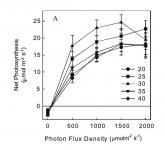Beta Test Team
Member
No one (that I'm aware of) is using only red radiation to grow Cannabis, or really any other plants. I think maybe you got some things turned around about what I wrote regarding photosynthetic efficiency (and this is pretty far off topic so I'll be brief). That study you're citing isn't a great resource for this discussion (I only posted about it in regards to intracanopy and intercanopy reflection of green photons):you posted this article
http://cpl.usu.edu/files/publications/poster/pub__3801011.pdf
View ImageView Image
View ImagePic drag and drop seems to not work. http://prntscr.com/5m49sn
unless I misunderstand something, thoes super power efficient red photons suck. No one wants the red vs the blue light fed plant above.
So exploiting the physics of super cheap red photons and arguing it is MORE EFFICIENT to mostly only provide red light is kinda bullshit, right? No one looking at that pic above is not willing to pay 35% more power for the blue plants vs the red plants.
I don't know what you mean by "super cheap red photons," because when I write about of efficiency it's about turning joule/s into unweighted photons within 400-700 nm.
In the example I mentioned, of Gavita, the spectrum isn't terrible, but it's not great, either. The point about photosynthetic efficiency I made was only to show the range of efficiencies available, to give context to Greenbeams and other CMH luminaire photosynthetic efficiencies.
Photosynthetic efficiency (umol/s within PAR range per joule/s) is very important to running a business, or even just a home grow for the anal retentive people. It's an important metric used to compare and understand luminaires, lamps, and reflectors (like the reflector 'photosynthetic radiation efficiency' metric I came up with yesterday).
That's not really the best way to do things, it's better to use PPF (unweighted photons), than YPF (yield photon flux), which is PPF adjusted (weighted) by how plants use PAR range photons for photosynthesis (what you're asking for). So it's better to use the photosynthetic efficiency I wrote about above, rather than what you're asking for. However, that said, using both is even better, as long as the former (PPF) is used as the primary data set.I have this question I am not sure I have the language to ask. Given the commonly understood par curve, and that light at the red end is way cheaper to make than a more balanced light SPD, how can we rate or quantify how well a given light source covers the "area under the PAR curve". And apply THAT efficiency of PAR coverage to the PPF efficiency?
This is too off topic for this thread for me to want to post a lot, so just very briefly: there are important limitations to doing what you're asking (using weighted photons), so it's more accurate to use PPF rather than YPF, when defining efficiencies and comparing lamps, when thinking about photosynthesis.
So the answer to your question is to find YPF efficiency (umol/J in PAR range weighted with how plants use photons for photosynthesis) you need to multiply lamp's SPD and the relative quantum efficiency (RQE) of photosynthesis by wavelength, then integrate all solutions and you get YPF, then finally divide by input joule/s (watt). (Our spreadsheet does this in an relative automated fashion.)
Yes, though like I wrote above, it's not preferred vs. unweighted photons for reasons I'd rather not explain here (they're off topic). All the graphs in the following thread represent the exact thing you're asking for, the data used to make those graphs are various RQEs, that when multiplied by relative or real spectral energy provide the weighted irradiance:Because I think it can/should be argued that the 2.1 umol of the DE 400V bulb (that is mostly only red) should be compared to the far better SPD of the 1.9 umol of the greenpower. And i suggest that IF that metric is well understood, then a thing we have noted; that perhaps the 942 bulb is perhaps as good as the agro. Not because it has the umol output, but because its lower umol better fits the PAR curve.
Does any sort of metric like that exist?
https://www.icmag.com/ic/showthread.php?p=6718314
And even if we used the RQE of photosynthesis to convert PPF to YPF (either by area, or not), the Gavita would still be greater due to the greater effect on photosynthetic rate from red range photons than blue and green.
To get a real understanding of spectrum quality, we need to adjust the PPF by many RQEs, such as that of photosynthesis, blue-light response, stomatal opening, stomatal closing, etc. (See the thread link for those curves.)
Last edited:



